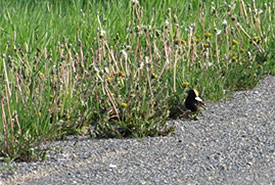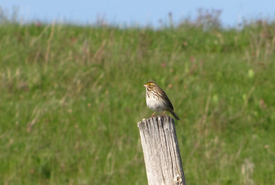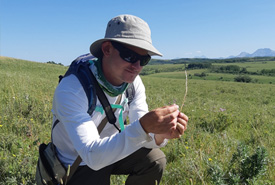Zachary Moore-University of Manitoba, Weston Family Conservation Science Fellow

Bobolink on road allowance between hayfields (Photo by Zachary M. Moore)
Impacts of Habitat, Landscape and Range Health on Grassland Songbirds in the Foothills Parkland Transition
I am working in the Nature Conservancy Canada’s (NCC’s) Waterton Park Front, studying how different factors impact grassland songbird populations. This area is a key transition between the Foothills Fescue and the Foothills Parkland natural subregions of Alberta and is home to a stunning array of biodiversity.
I’m going to conduct bird surveys throughout private conservation projects in this area. Then, I’ll relate them to the plant communities, the range health at each site, and take a step back to look at how the landscape changes in terms of the amount of grassland versus aspen forest. With all of this information, I will use models to determine what might be the most important things that determine if we find certain birds in a given area, and where else we might expect to find them.
What is the problem you are looking to solve or the question you are looking to answer?
Grasslands are an imperilled ecosystem, and grassland songbirds are the fastest declining bird group in North America. In addition, the Foothills Parkland is an understudied area with a lot of private conservation projects and cattle grazing. Right now, we understand how grazing, and landscape features interact to impact songbirds in other types of grassland habitat, but not in the complex, mosaic landscapes we find in this special transition area. Knowing species preferences for different aspects of the environment and how humans interact with that environment through cattle grazing is critical in identifying and protecting birds in these areas.
What impact are you hoping to achieve in Alberta (or beyond) with the project you are involved with?
My hope is that data will be able to influence predictive models for birds throughout the Parkland regions of Alberta. I hope NCC will be able to use my results to better identify and monitor bird populations on any current or future project they work on.
How can this project benefit NCC’s work and support other conservation initiatives?

Savannah sparrow on fence post (Photo by Zachary M. Moore)
My data will be shared directly with NCC to identify where there are species at risk, and to detail what conditions favour them. These models alone should be able to help predict where else we might expect to find bird species at risk in these areas. However, the data will also be put into a larger database that Environment and Climate Change Canada is putting together to thoroughly model bird species throughout the Canadian Prairies.
This project is also just the start of a larger science program NCC is working on. In this project, we’re really just getting a basic look at these communities; but after this is done, we can move onto a lot of other interesting research questions.
What will you learn from your project?
I will learn what birds are in the area, what affects each bird species here most, and how this area differs from other grasslands from the perspective of the birds that live here.
What is the project’s biggest achievement to date, or what are you looking forward to achieving in the coming months?
I am looking forward to the field season in June where I’ll be collecting all of the bird data! Field data collection is the best part of the type of research that I do.
What is your favourite part of the project you are working on?
I moved to this area for a Conservation Internship with NCC in the summer of 2019 and just fell in love with it. The Waterton Region itself is the reason I moved into this project for my master’s degree.
In an hour, you can drive from the flat grasslands into the rolling parkland and then in the Rockies. I love the landscape, the wildlife and the way the people here interact with the environment through their recreation, passion and work. I am proud to be working on a project that helps NCC to better relate this complex landscape and the dominant land use — cattle grazing — to the conservation of biodiversity.
What gets you excited about the species, habitat or theme your project is investigating?

Grass keying (Photo by Emily Pejic)
Besides walking around in the beautiful rolling foothills of the Rocky Mountains as the sun rises and all the wildlife starts to stir?
Well, being from Ontario, we don’t see a lot of bobolinks. Bobolinks are a threatened species under the Species at Risk Act, and this part of Alberta is one of THE hot spots for bobolinks in the Canadian grasslands. There are a ton of them out there. They are beautiful little black and yellow birds, and their song sounds suspiciously similar to R2D2. I am very excited to see what makes them tick in this area compared to others!
Is there a place where people who are interested in your project can go to learn more? Give us a website link and we will include it on our website.
Stay tuned for future updates!
A fun fact to share
One of the critical hypotheses I’ll be testing is how the impact of brown-headed cowbird nest parasitism changes as it moves into more forest-dominated landscapes. For anyone that’s unaware, they are just rude birds. Cowbirds lay their eggs in the nests of other unwitting species and leave them there for the other bird to raise. It’s thought that they may be one critical issue preventing grassland specialist birds from being successful close to the edges of the aspen forests.
Another fun fact is thinking about what makes most nests fail. One might think that cows would be a big problem for birds, as they might step on or even eat ground nests. But, in reality, predation by larger mammals, birds of prey and even ground squirrels might account for something like 80 per cent of failed nests, while cows might be responsible for something like two per cent. It’s just cool to think about how cattle on the landscape are so closely linked to the biodiversity of this region.





